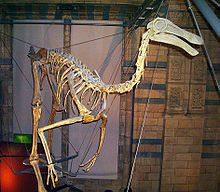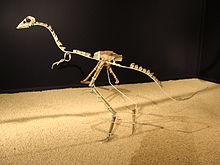
Gallimimus
About this schools Wikipedia selection
SOS Children have produced a selection of wikipedia articles for schools since 2005. SOS mothers each look after a a family of sponsored children.
| Gallimimus Temporal range: Late Cretaceous, 70Ma |
|
|---|---|
 |
|
| Mounted skeleton cast, Natural History Museum, London | |
| Scientific classification |
|
| Kingdom: | Animalia |
| Phylum: | Chordata |
| Class: | Reptilia |
| Order: | Saurischia |
| Superfamily: | †Ornithomimoidea |
| Family: | †Ornithomimidae |
| Genus: | †Gallimimus Osmólska, Roniewics & Barsbold, 1972 |
| Species: | † G. bullatus |
| Binomial name | |
| Gallimimus bullatus Osmólska, Roniewics & Barsbold, 1972 |
|
Gallimimus (pron.: / ˌ ɡ æ l ɨ ˈ m aɪ m ə s / GAL-i-MY-məs; meaning "chicken or rooster mimic") is a genus of ornithomimid theropod dinosaur from the late Cretaceous period ( Maastrichtian stage) Nemegt Formation of Mongolia. With individuals as long as 8 metres (26 ft), it was one of the largest ornithomimosaurs. Gallimimus is known from multiple individuals, ranging from juvenile (about 0.5 metres tall at the hip) to adult (about two metres tall at the hip).
Discovery
The first fossil remains of this dinosaur were discovered in early August 1963 by a team of Professor Zofia Kielan-Jaworowska at Tsagan Khushu during a Polish-Mongolian expedition to the Gobi Desert of Mongolia. The find was reported by her in 1965. In 1972, it was named and described by paleontologists Rinchen Barsbold, Halszka Osmólska, and Ewa Roniewicz. The only named species is the type species Gallimimus bullatus. The generic name is derived from Latin gallus, "chicken", and mimus, "mimic", in reference to the neural arches of the front neck vertebrae which resemble those of the Galliformes. The specific name is derived from Latin bulla, a magic capsule worn by Roman youth around the neck, in reference to a bulbous swelling in the braincase on the underside of the parasphenoid, in the form of a capsule.
The holotype specimen, IGM 100/11, consists of a partial skeleton including the skull and lower jaws. It is a larger skeleton; several other partial skeletons have been described, most of them of juveniles, and numerous single bones.
A second species announced by Barsbold in 1996, "Gallimimus mongoliensis" based on specimen IGM 100/14 from the older Bayanshiree Formation, has never been formally referred to this genus. In a reanalysis of the nearly complete skeleton of "Gallimimus mongoliensis" Barsbold concluded in 2006 that it is not a species of Gallimimus but may represent a new, currently unnamed ornithomimid genus.
Description
Gallimimus was rather ostrich-like, with a small head, toothless beak, large eyes, a long neck, short arms, long legs, and a long tail. A diagnostic character of Gallimimus is a distinctly short 'hand' relative to the humerus length, when compared to other ornithomimids. The tail was used as a counterbalance. The eyes were located on the sides of its head, meaning that it did not possess binocular vision. Like most modern birds and other theropods, it had hollow bones. Gallimimus had a number of adaptations which suggest good running ability, such as a strong ilium, heavy tail base, long limbs, a long tibia and metatarsus and short toes, but it is unknown how fast it could run. All ornithomimids had long skulls but that of Gallimimus was exceptionally elongated, due to an elongation of the snout. The snouts of the juvenile specimens are much shorter.
Norwegian researcher Jørn H. Hurum in 2001 published a detailed description of a complete lower jaw bone from Gallimimus bullatus. He noted new features in the "paper thin" jaw and corrects minor mistakes made in previous reconstructions of the lower jaw of G. bullatus. Hurum suggests that a "large widening of the anterior end of the prearticular" is an apomorphy for Gallimimus bullatus. He also notes that the tight intramandibular joint would prevent any movement between the front and rear portions of the lower jaw.
Phylogeny
Gallimimus was in 1972 assigned to the Ornithomimidae. This is confirmed by recent cladistic analyses.
Beak and Paleoecology
The feeding habits of ornithomimids have been controversial. The original describers thought Gallimimus preyed upon small animals, using its long arms as rakes to remove covering plant material on the soil. Later suggestions included omnivory and herbivory.
In 2001 Norell et al. reported a specimen of Gallimimus (IGM 100/1133): a skull with soft tissue preservation. This specimen, as well as another new fossil skull of Ornithomimus, had a keratinous beak with vertical grooves projecting from the bony upper mandible. These structures are reminiscent of the lamellae seen in ducks, in which they function to strain small edible items like plants, forams, mollusks, and ostracods from the water. The authors further noted that ornithomimids were abundant in mesic environments, and rarer in more arid environments, suggesting that they may have depended on waterborne sources of food, possibly filter feeding. They noted that primitive ornithomimids had well developed teeth, while derived forms were edentulous and probably could not feed on large animals.
One later paper questioned the conclusions of Norell et al. Barrett (2005) noted that vertical ridges are seen on the inner surface of the beaks of strictly herbivorous turtles, and also the hadrosaurid Edmontosaurus. Barrett also offered calculations, estimating how much energy could be derived from filter feeding and the probable energy needs of an animal as big as Gallimimus. He concluded that herbivory was more likely.
In popular culture
Gallimimus appeared in the motion picture Jurassic Park. A flock was seen running across a vast field from a Tyrannosaurus, which attacked and killed one of the ornithomimids. Gallimimus is also featured in the film's first sequel, The Lost World: Jurassic Park, during the 'roundup' sequence.



